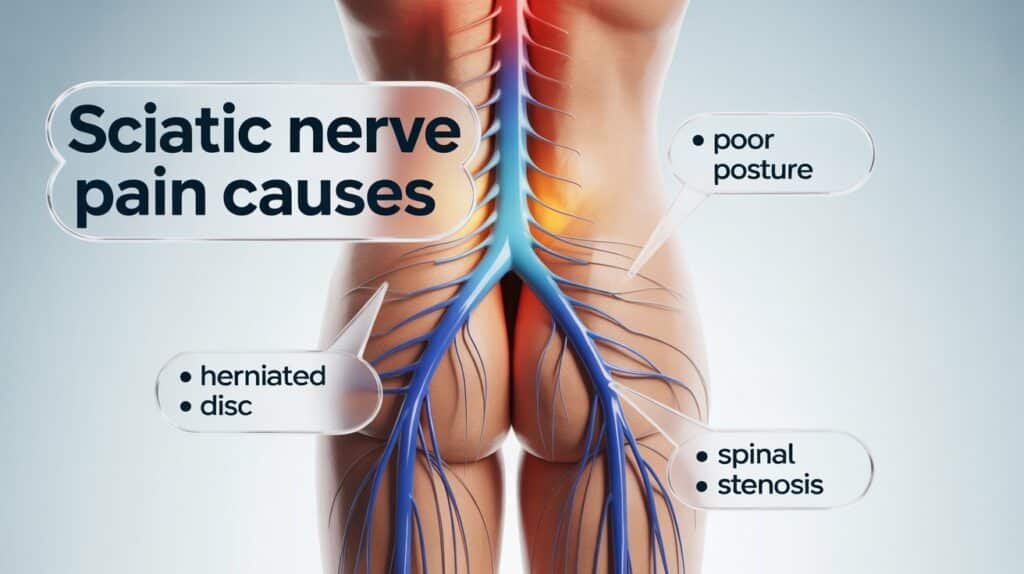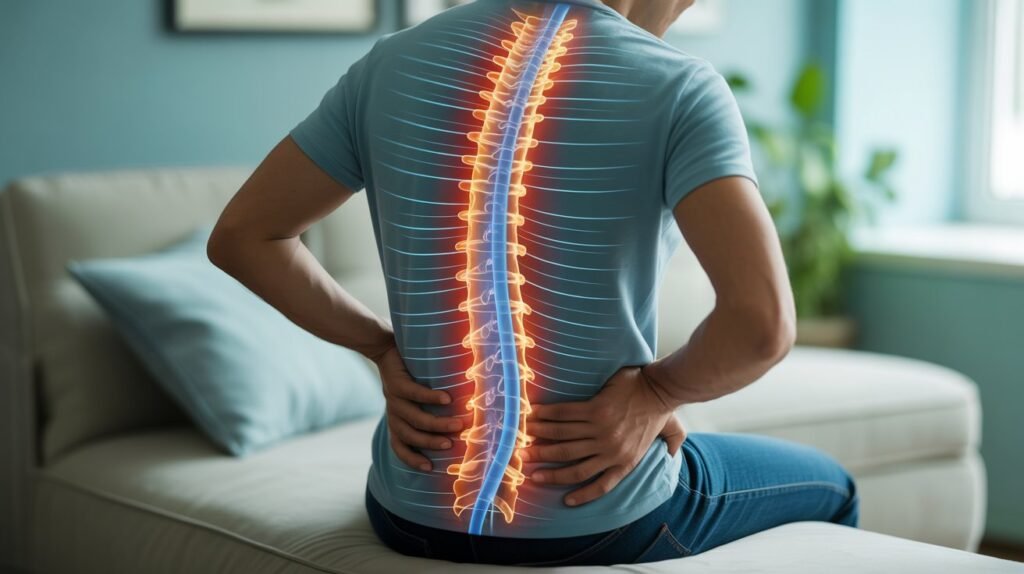Sciatic nerve pain causes are often misunderstood, but knowing them is the first step to finding real relief.

If you’ve ever felt a sharp, shooting pain running from your lower back down to your leg, you’re not alone.
This pain, also called sciatica, can make even simple tasks like sitting, walking, or sleeping feel impossible.
Did you know that up to 40% of people will experience sciatica at some point in their lives?
That’s nearly 4 in 10 people dealing with this painful condition.
By understanding the main sciatic nerve pain causes, you can take control of your health and start your journey toward effective nerve pain relief.
What Is Sciatic Nerve Pain?
Your sciatic nerve is the largest nerve in your body.
It runs from your lower back, through your hips and buttocks, and down both legs. When something irritates or compresses this nerve, it leads to sciatica pain.
Unlike regular back pain, which stays in one area, sciatic nerve pain travels, often starting in the lower back and radiating down the thigh, calf, or even to the toes. Some people feel sharp, stabbing pain, while others feel tingling, numbness, or weakness.
Common Sciatic Nerve Pain Causes
There are many reasons why the sciatic nerve can become irritated or compressed. Here are the most common causes:
1. Herniated or Slipped Disc
This is the number one cause of sciatica.
The discs in your spine act like cushions between the bones.
When a disc slips out of place or ruptures, it can press on the sciatic nerve, causing intense pain that shoots down the leg.
- Risk factors: heavy lifting, poor posture, or even a sudden injury.
- Fact: According to studies, about 90% of sciatica cases are linked to a herniated disc.
2. Spinal Stenosis
As we age, the spinal canal can narrow, a condition called spinal stenosis.
This puts pressure on the nerves, including the sciatic nerve.
- It’s more common in people over 50.
- Symptoms may worsen when standing or walking and improve when sitting or bending forward.
3. Degenerative Disc Disease
Over time, the discs in your spine naturally wear down.
This can lead to bone spurs or instability, which can irritate or compress the sciatic nerve.
- It’s one of the main reasons older adults experience sciatica pain.
4. Piriformis Syndrome
Not all sciatic nerve pain is caused by spinal problems.
Sometimes, the piriformis muscle, a small muscle in the buttocks, tightens or spasms and presses on the nerve.
- This condition is called piriformis syndrome.
- It’s common among runners, athletes, and people who sit for long periods.
5. Spondylolisthesis
This happens when one vertebra slips forward over another, creating nerve compression. It often leads to sciatica symptoms, such as leg weakness or numbness.
6. Traumatic Injury or Accidents
Falls, car accidents, or sports injuries can damage the spine, herniate a disc, or directly injure the sciatic nerve.
These cases may require more advanced sciatica treatment to heal properly.
7. Tumors or Infections (Rare Causes)
In very rare cases, tumors in the spine or infections can lead to sciatic nerve pain.
These need immediate medical attention and specialized care.
Risk Factors for Sciatic Nerve Pain
If you notice numbness, tingling, or weakness, don’t ignore it; these could be early signs of nerve damage that need attention.

- Sedentary lifestyle – sitting too much weakens your core and spine.
- Obesity – extra weight puts added pressure on your spine.
- Age – the natural aging process makes spinal issues more common.
- Poor posture – slouching strains the lower back.
- Heavy lifting – jobs or activities that involve frequent bending or lifting can increase risk.
- Genetics – some people are more prone to disc problems.
Symptoms of Sciatic Nerve Pain
Identifying the symptoms early can help you get the right sciatica treatment faster. Common signs include:
- Sharp pain radiating from the lower back to the legs
- Tingling or numbness in the buttocks, legs, or feet
- Weakness in the affected leg or foot
- Pain that worsens with movement like standing, walking, or sitting for long periods
- Difficulty sleeping or concentrating because of discomfort
How Doctors Diagnose Sciatica
If your pain is severe or lasts more than a week, a doctor may perform several tests to find the exact cause of your sciatic nerve pain:
- Physical exam: Checking reflexes, strength, and ability to lift legs.
- Imaging tests: MRI, CT scans, or X-rays to see if there’s a herniated disc or spinal issue.
- Nerve conduction studies: To check how well your nerves are working.
Managing and Treating Sciatic Nerve Pain
The good news is that most people with sciatica pain can find relief without surgery.
For quick relief at home, try these natural pain relief solutions that have helped thousands of people with sciatic nerve pain.
1. At-Home Remedies
- Rest and gentle movement: Avoid heavy activities, but don’t stay in bed for days; light walking helps.
- Heat and cold therapy: Ice packs can reduce inflammation in the first 48 hours, while heat pads ease muscle stiffness later.
- Stretching exercises: Gentle lower-back stretches can relieve pressure on the sciatic nerve.
2. Over-the-Counter Medications
- Non-steroidal anti-inflammatory drugs (NSAIDs) like ibuprofen can help reduce pain and swelling.
- Acetaminophen can be used for general nerve pain relief if anti-inflammatories aren’t suitable.
3. Physical Therapy
A physical therapist can teach you specific exercises that improve posture, strengthen core muscles, and relieve nerve compression.
Consistency here is key to long-term relief.
4. Injections and Advanced Treatments
If pain persists for weeks, your doctor might recommend:
- Steroid injections to reduce inflammation.
- Nerve root blocks to target the exact source of pain.
5. Surgery (Rare Cases)
Only about 5–10% of people with sciatica ever need surgery.
Procedures like a microdiscectomy remove the part of the disc pressing on the sciatic nerve.
This is typically reserved for severe cases with symptoms like significant weakness or loss of bladder control.
Preventing Sciatic Nerve Pain
While you can’t control all causes, many lifestyle changes can lower your risk of sciatica pain:
- Stay active: Walking, swimming, or yoga helps keep your back strong.
- Strengthen your core: Strong core muscles support your spine.
- Maintain good posture: Sit with your feet flat and back straight.
- Lift safely: Bend at the knees and keep heavy objects close to your body.
- Keep a healthy weight: Less strain on your spine means less chance of nerve compression.
When to See a Doctor
Seek medical attention right away if you experience:
- Severe pain that doesn’t improve with rest or medication.
- Loss of bladder or bowel control.
- Sudden, severe weakness or numbness in your leg.
These could be signs of a more serious problem requiring urgent sciatica treatment.
FAQs About Sciatic Nerve Pain Causes
Can stress cause sciatic nerve pain?
Stress itself doesn’t directly cause sciatica, but it can lead to muscle tension that worsens existing sciatica pain.
Is sciatic nerve pain always caused by a herniated disc?
No. While herniated discs are the most common cause, other issues like piriformis syndrome or spinal stenosis can also trigger pain.
How long does sciatic nerve pain last?
With proper care, mild cases may improve within a few weeks. Chronic or severe cases can last months without treatment.
Can lifestyle changes prevent sciatica from coming back?
Yes. Regular exercise, good posture, and proper lifting techniques are key to keeping the sciatic nerve healthy.
Final Thoughts
Sciatic nerve pain can be frustrating and even life-altering, but understanding its causes gives you the power to fight back.
Whether your pain stems from a herniated disc, spinal stenosis, or muscle strain, the right sciatica treatment can help you return to a pain-free life.
Remember, early action is important. Don’t ignore your symptoms or wait until the pain becomes unbearable.
Start with nerve pain relief strategies at home, consult a professional if needed, and make lifestyle adjustments to prevent future flare-ups.
Your spine supports everything you do; taking care of it today means a stronger, healthier, and more active tomorrow.